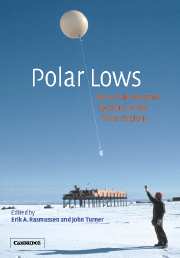4 - Theoretical investigations
Published online by Cambridge University Press: 07 December 2009
Summary
Introduction
During the 1970s, research into the theoretical understanding of high latitude mesocyclones was focused on the basic mechanisms of development of the more intense systems, known as polar lows. The aim was to explain the striking differences between polar lows and other extra-tropical cyclones, namely the small size and rapid growth rates of polar lows, and their favoured formation within cold air masses over the oceans in winter. It will become apparent by the end of this chapter that these fundamental questions have not been completely answered. However, considerable progress has been made, and new areas of research have been opened up regarding the life-cycle of polar lows, and their inter-action with the broadscale atmospheric flow.
The construction of mathematical and theoretical models of mesocyclones is not simple, because there are many types of vortices occurring in the high latitude areas. They vary widely in horizontal and vertical extent, in intensity and in structure. A mesocyclone may be a powerful system, extending through the depth of the troposphere, with intense deep convection and hurricane-force winds, or a weak swirl in the boundary-layer cloud, clearly visible on satellite imagery but with little significant weather at the Earth's surface. The environment in which the vortex forms may differ widely being, for example, a low-level frontal zone, or a flaccid low-pressure region at the centre of a decaying synoptic cyclone.
- Type
- Chapter
- Information
- Polar LowsMesoscale Weather Systems in the Polar Regions, pp. 286 - 404Publisher: Cambridge University PressPrint publication year: 2003
- 6
- Cited by



